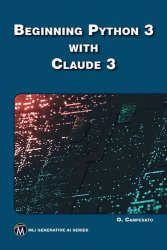 Название: Beginning Python 3 with Claude 3
Название: Beginning Python 3 with Claude 3Автор: O. Campesato
Издательство: Mercury Learning and Information
Год: 2025
Страниц: 270
Язык: английский
Формат: pdf (true), epub, mobi
Размер: 10.1 MB
This book is a comprehensive guide designed to teach the fundamentals of Python programming while introducing the exciting possibilities of Generative AI. Whether you're a novice or a developer looking to integrate Claude 3 into your workflow, this book offers a clear, step-by-step path to mastering Python and leveraging AI-driven code generation. It begins by covering Python fundamentals, including data types, string manipulation, loops, conditional logic, and exception handling. It then introduces Python collections, such as lists, dictionaries, and sets, along with their practical applications. Readers will explore essential Python libraries like NumPy and Pandas, learning how to manipulate data and perform advanced operations. The last two chapters cover Generative AI and Claude, distinguishing it from conversational AI and provides hands-on examples of Claude-generated Python code to solve various programming tasks. In essence, this book provides a modest bridge between the worlds of Python programming and AI, aiming to equip readers with the knowledge and skills to navigate both domains confidently. Readers will find a balanced mix of theory, practical examples, and Claude-generated code to build both foundational programming skills and an understanding of AI-driven development.
NumPy is a Python module that provides many convenience methods and also better performance. NumPy provides a core library for scientific computing in Python, with performant multidimensional arrays and good vectorized math functions, along with support for linear algebra and random numbers.
NumPy is modeled after MatLab, with support for lists, arrays, and so forth. NumPy is easier to use than Matlab, and it’s common in TensorFlow code as well as Python code.
Pandas is a Python package that is compatible with other Python packages, such as NumPy, Matplotlib, and so forth. In many ways the Pandas package has the semantics of a spreadsheet, and it also works with xsl, xml, html, csv file types. Pandas provides a data type called a DataFrame (similar to a Python dictionary) with extremely powerful functionality. Pandas DataFrames support a variety of input types, such as ndarrays, lists, dicts, or Series. Pandas also provides another data type called Pandas Series, this data structure provides another mechanism for managing data.
Features:
Covers Python programming basics and popular libraries like NumPy and Pandas, with a focus on practical applications
Introduces Generative AI concepts and Claude, showcasing its use in generating Python code
Includes companion files with code and images — available from the publisher for downloading (with proof of purchase)
The Target Audience:
This book is intended primarily for people who want to learn both Python and how to use Claude 3 with Python. This book is also intended to reach an international audience of readers with highly diverse backgrounds in various age groups. In addition, this book uses standard English rather than colloquial expressions that might be confusing to those readers. This book provide a comfortable and meaningful learning experience for the intended readers.
Although this book is introductory in nature, some knowledge of Python 3.x with certainly be helpful for the code samples. Knowledge of other programming languages (such as Java) can also be helpful because of the exposure to programming concepts and constructs. The less technical knowledge that you have, the more diligence will be required in order to understand the various topics that are covered.
Contents:
Скачать Beginning Python 3 with Claude 3
